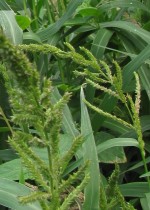 Barnyard grass is a summer annual native to tropical Asia but is widespread now in Europe as well as the United States. It grows in all states except Alaska and is especially common in the central and western states. Barnyardgrass prefers wet to moist fertile soil in full to partial sun and finds a home in marshes, swamps, and ditches as well as on the edges of ponds and rivers. It also invades disturbed sites such as vacant lots, gardens, lawns, and cropland and can cause serious loss in crop yield due to its tendency to take up nitrogen. In addition, it can become so high in nitrates that it is poisonous to livestock.
Barnyard grass is a summer annual native to tropical Asia but is widespread now in Europe as well as the United States. It grows in all states except Alaska and is especially common in the central and western states. Barnyardgrass prefers wet to moist fertile soil in full to partial sun and finds a home in marshes, swamps, and ditches as well as on the edges of ponds and rivers. It also invades disturbed sites such as vacant lots, gardens, lawns, and cropland and can cause serious loss in crop yield due to its tendency to take up nitrogen. In addition, it can become so high in nitrates that it is poisonous to livestock.
 Description: Seedlings first appear in the spring with more following after summer rains, and grow 1 to 5 feet tall. Each plant produces several erect, sometimes branched stems that may be tinged with red or maroon at the base, and go from round to flat in cross section as they mature. The alternate leaves are 4 to 20 inches long and ¾ inch wide, light green or blue-green, and often floppy. They lack ligules, the structure that clasps the stem, an important characteristic used to distinguish barnyardgrass from most other grasses. The flowers are produced in 4 to 16 inch terminal panicles consisting of several lateral, dark to light green spikelets. Tiny green beadlike seeds are produced each with a hairy bristle (awn) that is green or purplish, and 1/8th to ½ inch long. In the course of a season, a single plant can produce over a million seeds that can remain viable in the soil for 15 years. The root system is fibrous.
Description: Seedlings first appear in the spring with more following after summer rains, and grow 1 to 5 feet tall. Each plant produces several erect, sometimes branched stems that may be tinged with red or maroon at the base, and go from round to flat in cross section as they mature. The alternate leaves are 4 to 20 inches long and ¾ inch wide, light green or blue-green, and often floppy. They lack ligules, the structure that clasps the stem, an important characteristic used to distinguish barnyardgrass from most other grasses. The flowers are produced in 4 to 16 inch terminal panicles consisting of several lateral, dark to light green spikelets. Tiny green beadlike seeds are produced each with a hairy bristle (awn) that is green or purplish, and 1/8th to ½ inch long. In the course of a season, a single plant can produce over a million seeds that can remain viable in the soil for 15 years. The root system is fibrous.

 Control: Young plants are easily pulled from the soil especially when the soil is wet. Hoeing can be effective if the roots are fully exposed to the sun and air so they dry out rather than re-root and start growing again. Mowing heavily infested areas before seed production helps control future barnyardgrass populations. Application of preemergent herbicides such as benefin and bensulide before seed germination in the spring provides good to excellent control. The herbicide Pendemethalin can be used effectively both preemergent and early postemergence but don’t plant seeds in the areas where you have used a preemergent herbicide as the herbicide will prevent the growth of those seeds too.
Control: Young plants are easily pulled from the soil especially when the soil is wet. Hoeing can be effective if the roots are fully exposed to the sun and air so they dry out rather than re-root and start growing again. Mowing heavily infested areas before seed production helps control future barnyardgrass populations. Application of preemergent herbicides such as benefin and bensulide before seed germination in the spring provides good to excellent control. The herbicide Pendemethalin can be used effectively both preemergent and early postemergence but don’t plant seeds in the areas where you have used a preemergent herbicide as the herbicide will prevent the growth of those seeds too.